One of the greatest Dutch artists in history lived during the most remarkable period in Dutch history, the Dutch Golden Age. Rembrandt Harmenszoon van Rijn (1606-1669) can easily be described as one of the greatest masters of the Baroque era in history.
Although his paintings are what makes him such a famous Dutch artist, he was also a very prolific draughtsman and etcher. His etchings are still considered to be of the highest quality ever created, even today.
His extensive oeuvre consists of a wide variety of themes and subject matter, including portraits, self-portraits, genre scenes, landscapes, animal studies, as well as biblical, allegorical, and mythological themes.
He was considered to be one of the greatest Dutch artists in history while he was still alive, and this reputation still stands today. Let’s take a closer look at some of the most famous Rembrandt paintings so you can understand why.
1. The Night Watch
- Date created: 1642
- Dimensions: 363 × 437 centimeters (142.9 × 172.0 inches)
- Location: Rijksmuseum, Amsterdam, Netherlands
The Night Watch is without a doubt the magnum opus of Rembrandt van Rijn. It’s an enormous painting that depicts a military group as they are about to embark on a mission. It uses a sense of tenebrism influenced by the paintings of Caravaggio who developed this dramatic style in the early 17th century.
The other remarkable feature about this painting is that it invokes a perception of motion, something quite remarkable considering this was intended to be a group portrait. Although the painting is owned by the Amsterdam Museum, it’s usually on display at the Rijksmuseum in Amsterdam.

2. The Storm on the Sea of Galilee
- Date created: 1633
- Dimensions: 160 × 128 centimeters (62.99 × 50.39 inches)
- Location: Unknown
The Storm on the Sea of Galilee is not only one of the most famous Rembrandt paintings, but also one of the most intriguing ones for several reasons. It’s the artist’s only seascape and depicts a story mentioned in the Gospel of Mark in which Jesus Christ calms the Sea of Galilee (which is a freshwater lake in modern-day Israel).
One of the men inside the boat looks directly at the viewer and this is a self-portrait of the artist. Another follower of Jesus can be seen vomiting as he is hanging out of the boat. The painting was one of the 13 paintings that were stolen from the Isabella Stewart Gardner Museum in Boston in 1990 and its whereabouts remain unknown until today.
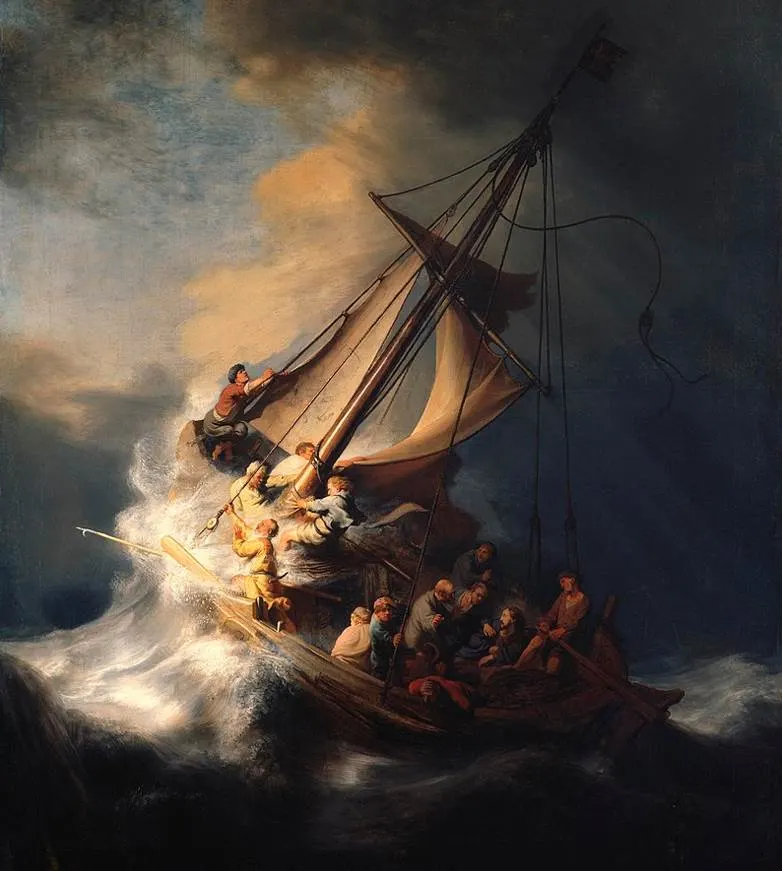
3. The Jewish Bride
- Date created: 1665-1669
- Dimensions: 121.5 × 166.5 centimeters (47.8 × 65.6 inches)
- Location: Rijksmuseum, Amsterdam, Netherlands
The Jewish Bride got its name in the 19th century when it was assumed that the painting depicted a Jewish father offering a necklace to his daughter before her marriage. This interpretation isn’t accepted by modern-day art historians and the identity of the couple remains unknown today.

Another remarkable element about this painting is that there are no clues as to who the couple might be. Only the central figures in the portrait are depicted with a cloud of mystery hanging over them, making it another very intriguing painting in the oeuvre of Rembrandt.
4. The Anatomy Lesson of Dr. Nicolaes Tulp
- Date created: 1632
- Dimensions: 216.5 × 169.5 centimeters (85.2 × 66.7 inches)
- Location: Mauritshuis, The Hague, Netherlands
The Anatomy Lesson of Dr. Nicolaes Tulp is one of the ultimate masterpieces of Rembrandt which he painted during the early phase of his career. The figure on the right is a man identified as Nicolaes Tulp, the mayor of Amsterdam who was also a surgeon.
He can be seen giving an anatomy lesson using a corpse to a group of doctors. What’s remarkable about this painting is that multiple of the included doctors, who were members of the Amsterdam Guild of Surgeons, actually paid Rembrand to be included in this remarkable work of art.

5. The Woman Taken in Adultery
- Date created: 1644
- Dimensions: 83.8 x 65.4 centimeters (33 x 25.75 inches)
- Location: National Gallery, London, United Kingdom
The Woman Taken in Adultery depicts the story of arguably one of the most famous sayings uttered by Jesus Christ according to the Bible. The story is mentioned in the Gospel of Saint John and describes a group of Jews about to stone a woman for adultery.
They tricked Jesus and attempted to make him go against the Jewish Law. When they captured the woman they asked Jesus what to do and he simply replied “He that is without sin among you, let him first cast a stone at her.” Rembrandt depicted Jesus as being much taller than all other figures in this painting which is on display at the National Gallery in London.
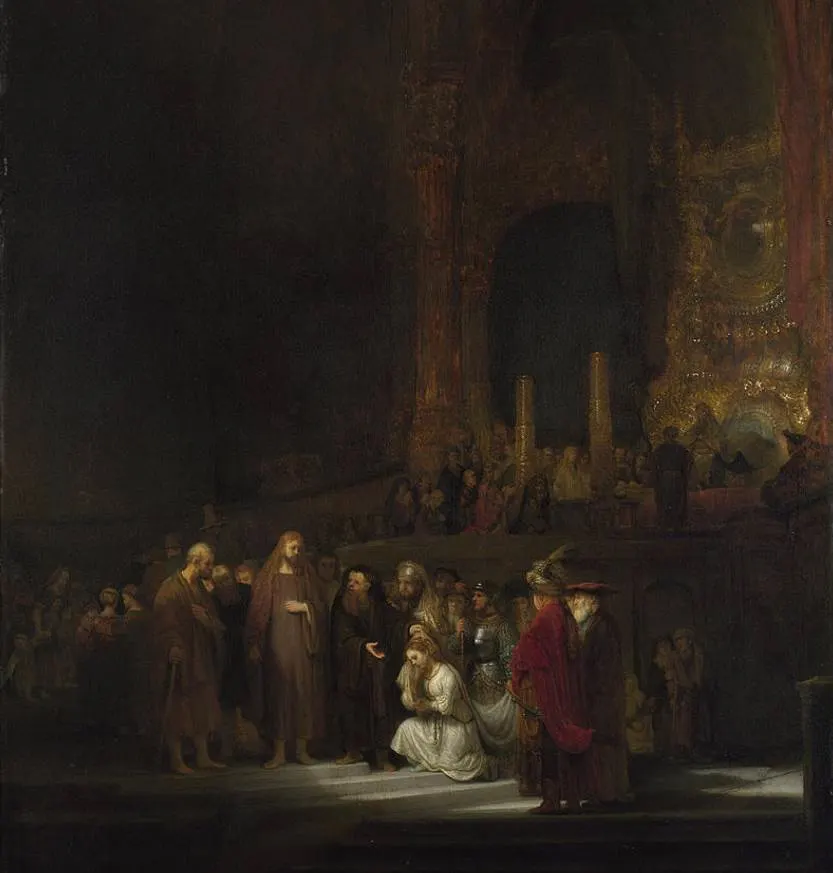
6. Bathsheba at Her Bath
- Date created: 1654
- Dimensions: 142 × 142 centimeters (56 × 56 inches)
- Location: Louvre Museum, Paris, France
Bathsheba at Her Bath depicts a story from the Old Testament in which King David sees Bathsheba bathing. He not only seduces and impregnates her shortly after but also sends out her husband to a battle without his general by his side, a virtual death sentence.
This particular story has been depicted multiple times by artists from a variety of art movements. Rembrandt’s version focuses on a subtle sense of eroticism which he achieves by contrasting the bright color of Bathsheba’s body with the dark colors of the surroundings. It’s part of the collection for the Louvre Museum in Paris.
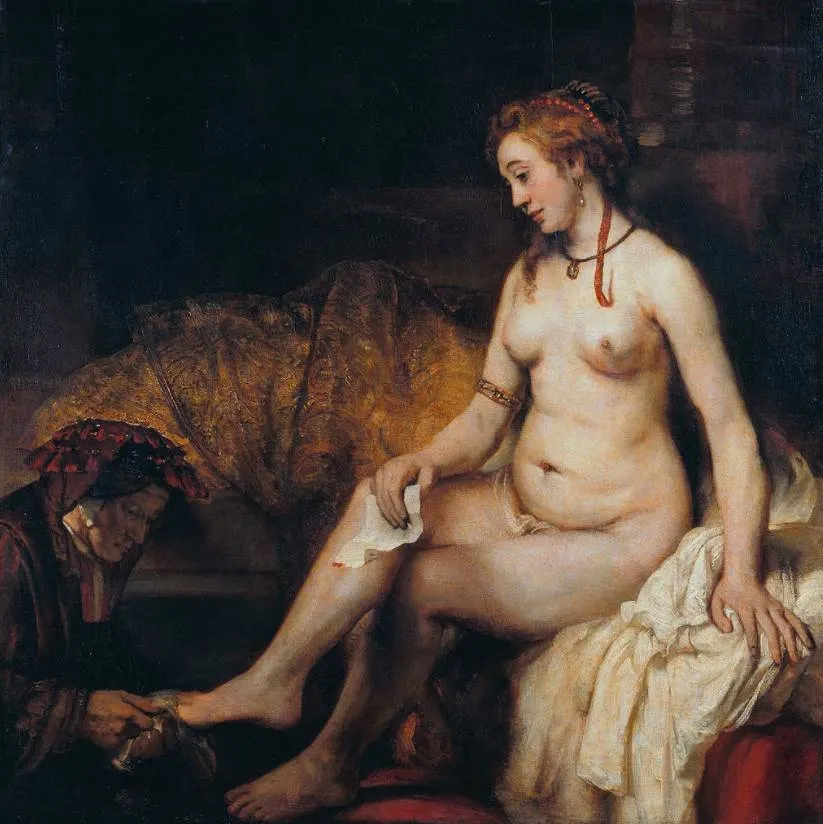
7. Belshazzar’s Feast
- Date created: 1635-1638
- Dimensions: 167.6 × 209.2 centimeters (66 × 82.4 inches)
- Location: National Gallery, London, United Kingdom
Belshazzar’s Feast is another depiction of a story from the Old Testament also known as “The Writing on the Wall.” It depicts God writing a phrase on the wall after King Belshazzar has thrown an immense party which God has considered to be blasphemy.
The text says “mene, mene, tekel, upharsin” which has been translated as “God has numbered the days of your kingdom and brought it to an end; you have been weighed in the balances and found wanting; your kingdom is given to the Medes and Persians.” This particular saying is still used today to make an obvious prediction.
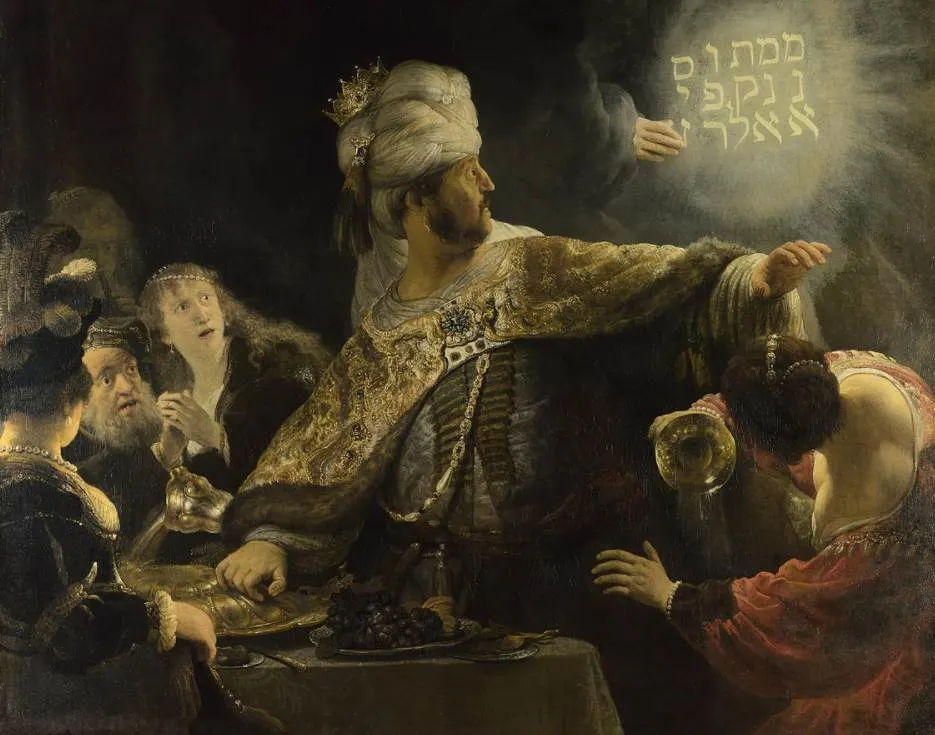
8. The Return of the Prodigal Son
- Date created: 1661-1669
- Dimensions: 262 × 205 centimeters (103.15 x 80.7 inches)
- Location: Hermitage Museum, Saint Petersburg, Russia
The Return of the Prodigal Son is considered to be one of the final paintings that Rembrandt ever created in his life and one of the masterpieces of this final phase in his career. It depicts the moment that the youngest son of a father returns to him after he squandered all his money.
Instead of being angry, the father welcomes his son back with open arms. When his older brother becomes angry about the situation, the father says “You are ever with me, and all that I have is yours, but thy younger brother was lost and now he is found.” The raw emotion depicted by Rembrandt in this painting is characteristic of many works in his oeuvre.
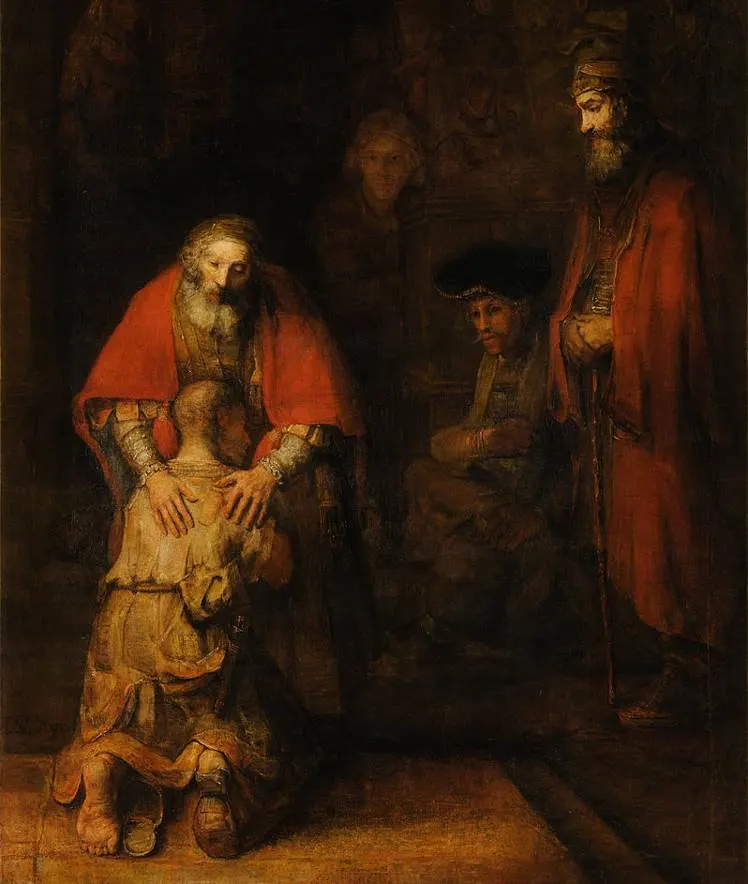
9. Syndics of the Drapers’ Guild
- Date created: 1662
- Dimensions: 191.5 × 279 centimeters (75.4 × 110 inches)
- Location: Rijksmuseum, Amsterdam, Netherlands
Syndics of the Drapers’ Guild is also known as “The Sampling Officials.” It”s not just one of the many group portraits of members of a particular Guild that Rembrandt painted, but is also considered to be one of the final great group portraits he ever produced.
These men were drapers, wholesale merchants of cloth, who can be seen assessing the quality of the cloth they were about to buy from local weavers. The original title of the painting was “De Staalmeesters.” The word “steal” refers to the sample of the cloth that the men are inspecting.

10. Self-Portrait with Beret and Turned-Up Collar
- Date created: 1659
- Dimensions: 84.4 × 66 centimeters (33.2 × 26 inches)
- Location: National Gallery of Art, Washington, D.C., United States
Self-Portrait with Beret and Turned-Up Collar is one of the over 40 self-portraits that Rembrandt van Rijn created in his life. This portrait was painted about 10 years before the artist passed away and reveals the bleak financial situation in which the artist spent the final decade of his life.
It’s one of the many paintings that entered the collection of the National Gallery of Art in Washington D.C. after being acquired by Andrew W. Mellon (155-1937) in 1929. It was gifted to the museum in 1937 following the death of the rich American banker and industrialist.

